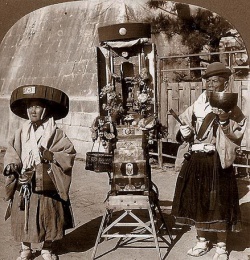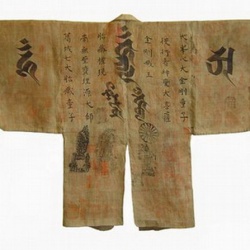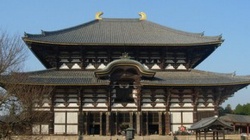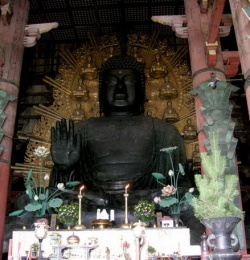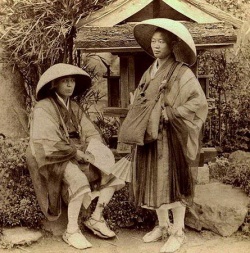Difference between revisions of "Buddhist Pilgrimage Sites: Japan"
(Created page with "<poem> According to Nihon Shoki (the Chronicles of Japan), Buddhism was introduced to Japan in 552 AD by Korean monks. Sutras were later brought from ...") |
|||
| Line 1: | Line 1: | ||
| + | [[File:565_rge.jpg|thumb|250px|]] | ||
<poem> | <poem> | ||
| − | According to Nihon Shoki (the [[Chronicles of Japan]]), [[Buddhism]] was introduced to [[Japan]] in 552 AD by [[Korean]] [[monks]]. [[Sutras]] were later brought from [[China]], [[temples]] and [[shrines]] were built and [[monastic]] communities established. | + | According to {{Wiki|Nihon Shoki}} (the [[Chronicles of Japan]]), [[Buddhism]] was introduced to [[Japan]] in 552 AD by [[Korean]] [[monks]]. [[Sutras]] were later brought from [[China]], [[temples]] and [[shrines]] were built and [[monastic]] communities established. |
| − | + | [[File:5515_90.jpg|thumb|250px|]] | |
During the 8th century there were initially six [[schools of Buddhism]] based in [[Nara]]: | During the 8th century there were initially six [[schools of Buddhism]] based in [[Nara]]: | ||
| − | + | [[File:5523_x163.jpg|thumb|250px|]] | |
[[Ritsu]] ([[Vinaya]]) | [[Ritsu]] ([[Vinaya]]) | ||
[[Jojitsu]] (Satyasiddhi) | [[Jojitsu]] (Satyasiddhi) | ||
| Line 10: | Line 11: | ||
[[Hosso]] ([[Yogacara]]) | [[Hosso]] ([[Yogacara]]) | ||
[[Kegon]] ([[Huayen]]). | [[Kegon]] ([[Huayen]]). | ||
| − | + | [[File:55226-large.jpg|thumb|250px|]] | |
[[Esoteric Buddhism]] was then introduced from [[China]] by [[Kukai]] and [[Saicho]] who founded the [[Shingon]] and [[Tendai]] schools. The [[Kamakura period]] (1185-1333) saw the [[emergence]] of the extremely popular [[Pure Land Buddhism]] (the {{Wiki|worship}} of [[Amida]]) and [[Zen Buddhism]]. | [[Esoteric Buddhism]] was then introduced from [[China]] by [[Kukai]] and [[Saicho]] who founded the [[Shingon]] and [[Tendai]] schools. The [[Kamakura period]] (1185-1333) saw the [[emergence]] of the extremely popular [[Pure Land Buddhism]] (the {{Wiki|worship}} of [[Amida]]) and [[Zen Buddhism]]. | ||
| − | + | [[File:56528-la_ge.jpg|thumb|250px|]] | |
Koyasan | Koyasan | ||
| − | Set in the forests of the Kii Mountains in the north-eastern part of Wakayama Prefecture, [[south]] of Osaka, three [[sacred]] sites - [[Yoshino]] and Omine, Kumano Sanzan and Koyasan (Mount Koya) - are linked by [[pilgrimage]] routes to the {{Wiki|ancient}} [[Japanese]] {{Wiki|capital}} cities of [[Nara]] and [[Kyoto]]. Each site contains [[shrines]], some of which were founded as early as the 9th century and reflect the fusion of [[Shinto]] (Japan's native [[belief]] system rooted in the {{Wiki|ancient}} [[tradition]] of [[nature]] {{Wiki|worship}}) and [[Buddhism]], which was introduced into [[Japan]] in the 6th century from [[China]] and the {{Wiki|Korean Peninsula}}. The [[tradition]] of [[pilgrimage]] to [[sacred mountains]] was practised by members of the {{Wiki|imperial}} family, [[nobility]], {{Wiki|warriors}} and [[Buddhist]] [[monks]] and in later years larger groups from the general population. | + | Set in the forests of the [[Kii Mountains]] in the north-eastern part of Wakayama Prefecture, [[south]] of {{Wiki|Osaka}}, three [[sacred]] sites - [[Yoshino]] and [[Omine]], [[Kumano]] [[Sanzan]] and [[Koyasan]] ([[Mount Koya]]) - are linked by [[pilgrimage]] routes to the {{Wiki|ancient}} [[Japanese]] {{Wiki|capital}} cities of [[Nara]] and [[Kyoto]]. Each site contains [[shrines]], some of which were founded as early as the 9th century and reflect the fusion of [[Shinto]] (Japan's native [[belief]] system rooted in the {{Wiki|ancient}} [[tradition]] of [[nature]] {{Wiki|worship}}) and [[Buddhism]], which was introduced into [[Japan]] in the 6th century from [[China]] and the {{Wiki|Korean Peninsula}}. The [[tradition]] of [[pilgrimage]] to [[sacred mountains]] was practised by members of the {{Wiki|imperial}} family, [[nobility]], {{Wiki|warriors}} and [[Buddhist]] [[monks]] and in later years larger groups from the general population. |
| − | On the peak of Koyasan is Kongobuji, the main [[temple]] of the [[esoteric]] [[Shingon]] [[Buddhist]] sect; the [[temple]] was founded in 816 by the [[monk]] and [[scholar]] [[Kukai]] (774-835), better known by his posthumous title [[Kobo Daishi]]. Koyasan was believed to have been a [[sacred mountain]] for [[ascetic]] practitioners even before [[Kukai]] received {{Wiki|imperial}} permission to found his [[religious]] {{Wiki|community}} there. A Designated National [[Treasure]], the complex today comprises more than 120 [[temples]]. The Inner [[Sanctuary]] is the setting for a vast cemetery that includes the mausolea of many famous [[Japanese]], including that of the 16th century {{Wiki|samurai}} ruler, Toyotomi Hideyoshi. The 25 metre high Daimon Gate and has served as the main entrance to the [[temple]] ever since its foundation. | + | On the peak of Koyasan is Kongobuji, the main [[temple]] of the [[esoteric]] [[Shingon]] [[Buddhist]] sect; the [[temple]] was founded in 816 by the [[monk]] and [[scholar]] [[Kukai]] (774-835), better known by his posthumous title [[Kobo Daishi]]. [[Koyasan]] was believed to have been a [[sacred mountain]] for [[ascetic]] practitioners even before [[Kukai]] received {{Wiki|imperial}} permission to found his [[religious]] {{Wiki|community}} there. A Designated National [[Treasure]], the complex today comprises more than 120 [[temples]]. The Inner [[Sanctuary]] is the setting for a vast cemetery that includes the mausolea of many famous [[Japanese]], including that of the 16th century {{Wiki|samurai}} ruler, [[Toyotomi Hideyoshi]]. The 25 metre high [[Daimon Gate]] and has served as the main entrance to the [[temple]] ever since its foundation. |
The area today is part of the living {{Wiki|culture}} of [[Japan]] and attracts some 15 million visitors annually. Lodging facilities are provided by the [[temple]] for [[pilgrims]], but are also available to visitors. | The area today is part of the living {{Wiki|culture}} of [[Japan]] and attracts some 15 million visitors annually. Lodging facilities are provided by the [[temple]] for [[pilgrims]], but are also available to visitors. | ||
| Line 23: | Line 24: | ||
[[Nara]] | [[Nara]] | ||
| − | [[Buddhism]] was introduced to [[Japan]] in 552 AD. During the 8th century, a number of [[temples]] and [[shrines]] were [[constructed]] in [[Nara]] including the huge [[temple]] of Todaiji (Great Eastern [[Temple]]), commissioned by [[Wikipedia:Emperor Shōmu|Emperor Shomu]] (ruled 724-49). Todaiji had been destroyed by [[fire]] and re-built several times but the Great [[Buddha]] Hall (Daibutsuden) of the current building is still the largest wooden structure in the [[world]] and contains a colossal bronze statue of [[Vairocana]], [[standing]] 15 metres high weighing around 400 tonnes. Other important [[temples]] and [[shrines]] in [[Nara]] include Saidaiji, Kofukuji, Gangoji, Yakushiji, Toshodaiji and Kasuga [[shrine]]. | + | [[Buddhism]] was introduced to [[Japan]] in 552 AD. During the 8th century, a number of [[temples]] and [[shrines]] were [[constructed]] in [[Nara]] including the huge [[temple]] of [[Todaiji]] ([[Great Eastern [[Temple]]), commissioned by [[Wikipedia:Emperor Shōmu|Emperor Shomu]] (ruled 724-49). [[Todaiji]] had been destroyed by [[fire]] and re-built several times but the Great [[Buddha]] Hall ([[Daibutsuden]]) of the current building is still the largest wooden structure in the [[world]] and contains a colossal bronze statue of [[Vairocana]], [[standing]] 15 metres high weighing around 400 tonnes. Other important [[temples]] and [[shrines]] in [[Nara]] include [[Saidaiji]], [[Kofukuji]], [[Gangoji]], [[Yakushiji]], [[Toshodaiji]] and [[Kasuga]] [[shrine]]. |
Saikoku [[Kannon]] [[Pilgrimage]] | Saikoku [[Kannon]] [[Pilgrimage]] | ||
| − | This [[traditional]] [[pilgrimage]] route includes [[thirty-three]] [[temples]] dedicated to [[Kannon]] in {{Wiki|Western}} [[Japan]]. [[Kannon]] (the [[Japanese]] [[name]] for the [[bodhisattva]] [[Avalokitesvara]], [[Bodhisattva]] of [[Compassion]]) is believed to have the ability to take 33 different [[forms]]. This is the most likely {{Wiki|reasoning}} behind the development of the [[thirty-three]] [[temples]] to be found on this 1500-mile [[pilgrimage]] that stretches from Lake Biwa to Kobe and touches Japan's [[east]] and [[west]] coasts. | + | This [[traditional]] [[pilgrimage]] route includes [[thirty-three]] [[temples]] dedicated to [[Kannon]] in {{Wiki|Western}} [[Japan]]. [[Kannon]] (the [[Japanese]] [[name]] for the [[bodhisattva]] [[Avalokitesvara]], [[Bodhisattva]] of [[Compassion]]) is believed to have the ability to take 33 different [[forms]]. This is the most likely {{Wiki|reasoning}} behind the development of the [[thirty-three]] [[temples]] to be found on this 1500-mile [[pilgrimage]] that stretches from Lake Biwa to [[Kobe]] and touches Japan's [[east]] and [[west]] coasts. |
The [[pilgrimage]] route possibly dates from as early as the 11th century, but many of the [[temples]] (some date to the 7th century) were the focus of earlier [[pilgrimage]] in their own right. [[Traditionally]] [[pilgrims]] would walk the route and visit the [[temples]] in order from 1 to 33, but today they can also be reached in day-trips from [[Kyoto]] using public transport and a contemporary [[pilgrim]] can easily average two [[temples]] each day. The complete [[pilgrimage]] can also be accomplished in a 'model' [[form]] at Ishiyamadera near [[Kyoto]], where a circuit can be made ofthirty-threestone [[Buddhist]] images in the [[temple]] grounds. | The [[pilgrimage]] route possibly dates from as early as the 11th century, but many of the [[temples]] (some date to the 7th century) were the focus of earlier [[pilgrimage]] in their own right. [[Traditionally]] [[pilgrims]] would walk the route and visit the [[temples]] in order from 1 to 33, but today they can also be reached in day-trips from [[Kyoto]] using public transport and a contemporary [[pilgrim]] can easily average two [[temples]] each day. The complete [[pilgrimage]] can also be accomplished in a 'model' [[form]] at Ishiyamadera near [[Kyoto]], where a circuit can be made ofthirty-threestone [[Buddhist]] images in the [[temple]] grounds. | ||
| Line 36: | Line 37: | ||
{{Wiki|Shikoku}} | {{Wiki|Shikoku}} | ||
| − | The 88 [[Temple]] [[pilgrimage]] on {{Wiki|Shikoku}} is Japan's most famous [[pilgrimage]] route. The circuit encompasses the entire island through 88 [[temples]] as well as an optional 20 'unnumbered' [[temples]]. Many of the [[temples]] on this [[pilgrimage]] route are said to have been founded or restored by the renowned [[Buddhist monk]] and [[scholar]] [[Kukai]] (774-835), better known by his posthumous title [[Kobo Daishi]]. Among his many achievements he is said to have created the simplified [[Japanese]] '[[kana]]' syllabary, (a simplified [[form]] of the written [[Japanese]] [[language]]). He is also credited with bringing the [[tantric teachings]] of [[esoteric Buddhism]] from [[China]] and developing it into the uniquely [[Japanese]] [[Shingon]] sect, founding their headquarters on Mount Koya (Koyasan) near Osaka. | + | The 88 [[Temple]] [[pilgrimage]] on {{Wiki|Shikoku}} is Japan's most famous [[pilgrimage]] route. The circuit encompasses the entire island through 88 [[temples]] as well as an optional 20 'unnumbered' [[temples]]. Many of the [[temples]] on this [[pilgrimage]] route are said to have been founded or restored by the renowned [[Buddhist monk]] and [[scholar]] [[Kukai]] (774-835), better known by his posthumous title [[Kobo Daishi]]. Among his many achievements he is said to have created the simplified [[Japanese]] '[[kana]]' syllabary, (a simplified [[form]] of the written [[Japanese]] [[language]]). He is also credited with bringing the [[tantric teachings]] of [[esoteric Buddhism]] from [[China]] and developing it into the uniquely [[Japanese]] [[Shingon]] sect, founding their headquarters on [[Mount Koya]] ([[Koyasan]]) near Osaka. |
First references to the {{Wiki|Shikoku}} [[pilgrimage]] can be found in [[Japanese]] documents from the 12th century, although neither the established route nor specific [[temples]] are mentioned. The 88 [[Temple]] [[pilgrimage]] route as it is known today is believed to have become established some [[time]] during the 16th or 17th centuries. | First references to the {{Wiki|Shikoku}} [[pilgrimage]] can be found in [[Japanese]] documents from the 12th century, although neither the established route nor specific [[temples]] are mentioned. The 88 [[Temple]] [[pilgrimage]] route as it is known today is believed to have become established some [[time]] during the 16th or 17th centuries. | ||
| − | While most modern-day [[pilgrims]] (an estimated 100,000 yearly) travel by tour bus, often only to specific [[temples]], a small but significant minority of [[Japanese]] and non-Japanese still set out the old fashioned way on foot, a journey which takes about six weeks to complete. These [[pilgrims]], known in [[Japanese]] as 'o-henro-sama' can be seen at the [[temples]] and along the roadsides of {{Wiki|Shikoku}} clad in a white jacket bearing the characters 'Dogyo Futari' (meaning 'two travelling together'), the companion here being the [[spirit]] of [[Kobo Daishi]]. | + | While most modern-day [[pilgrims]] (an estimated 100,000 yearly) travel by tour bus, often only to specific [[temples]], a small but significant minority of [[Japanese]] and non-Japanese still set out the old fashioned way on foot, a journey which takes about six weeks to complete. These [[pilgrims]], known in [[Japanese]] as 'o-henro-sama' can be seen at the [[temples]] and along the roadsides of {{Wiki|Shikoku}} clad in a white jacket bearing the characters '[[Dogyo Futari]]' (meaning '[[two travelling together]]'), the companion here being the [[spirit]] of [[Kobo Daishi]]. |
Myoshinji and Ryoanji, [[Kyoto]] | Myoshinji and Ryoanji, [[Kyoto]] | ||
| − | [[Japanese]] [[Zen Buddhism]] derives from [[Mahayana Buddhism]], and is known in {{Wiki|Chinese}} as [[Chan]], which itself derives from the [[Sanskrit]] [[Dhyana]] '[[meditation]]'. [[Zen]] emphasises the [[form]] of [[meditation]] known as [[Zazen]] - which aims to achieve personal [[awakening]]. There are three main schools of [[Zen]] in [[Japan]] today: [[Sōtō]], [[Rinzai]] and Obaku of which [[Sōtō]] is the largest and Obaku the smallest. [[Rinzai]] [[Zen Buddhism]] is divided into several subschools based on [[temple]] affiliation and is centred in [[Kyoto]] in [[temples]] such as Myoshinji, [[Nanzenji]], Tenryuji, [[Daitokuji]] and Tofukuji. | + | [[Japanese]] [[Zen Buddhism]] derives from [[Mahayana Buddhism]], and is known in {{Wiki|Chinese}} as [[Chan]], which itself derives from the [[Sanskrit]] [[Dhyana]] '[[meditation]]'. [[Zen]] emphasises the [[form]] of [[meditation]] known as [[Zazen]] - which aims to achieve personal [[awakening]]. There are three main schools of [[Zen]] in [[Japan]] today: [[Sōtō]], [[Rinzai]] and [[Obaku]] of which [[Sōtō]] is the largest and [[Obaku]] the smallest. [[Rinzai]] [[Zen Buddhism]] is divided into several subschools based on [[temple]] affiliation and is centred in [[Kyoto]] in [[temples]] such as [[Myoshinji]], [[Nanzenji]], [[Tenryuji]], [[Daitokuji]] and [[Tofukuji]]. |
| − | [[Zen Buddhism]] was introduced into [[Japan]] as a separate school in the 12th century, when [[Myōan Eisai]] travelled to [[China]] and returned to establish the [[Rinzai]] [[lineage]] of which the Myoshinji school is the largest. The Myoshinji [[temple]] complex in the north-west of [[Kyoto]] is the head [[temple]] of the [[Rinzai]] sect of [[Buddhism]] and was founded in 1337 by the retired | + | [[Zen Buddhism]] was introduced into [[Japan]] as a separate school in the 12th century, when [[Myōan Eisai]] travelled to [[China]] and returned to establish the [[Rinzai]] [[lineage]] of which the [[Myoshinji]] school is the largest. The [[Myoshinji]] [[temple]] complex in the north-west of [[Kyoto]] is the head [[temple]] of the [[Rinzai]] sect of [[Buddhism]] and was founded in 1337 by the retired {{Wiki|emperor Hanazono}} (ruled 1308-18), who practiced [[Zen]] under the distinguished [[master]] [[Soho Myocho]]. Although completely destroyed during the Onin Wars (1467-77), the [[temple]] was restored by its ninth [[abbot]], [[Sekko Sojin]] (1408-86). The [[Myoshinji]] complex contains 57 sub-temples and chapels, many of which are [[attached]] to tombs of [[daimyo]] (regional [[warlord]]) patrons, and plays an active part in the daily [[life]] of the local {{Wiki|community}}. There are more than 3,000 affiliated [[temples]] across [[Japan]]. The [[Myoshinji]] complex is noted for its many [[art]] [[objects]], its superb [[gardens]], and its [[temple bell]], the oldest in [[Japan]]. The [[temple]] complex includes Shunkoin, a small [[temple]] established in 1590. It has important [[art]] works and a [[Zen]] dry-stone garden (karesansui) and offers visitors from all over the [[world]] the opportunity to [[experience]] [[Zazen]] [[meditation]]. |
| − | Perhaps the most well-known [[Rinzai]] centre in [[Kyoto]] is the nearby [[temple]] of Ryoanji, ([[Temple]] of the [[Peaceful]] [[Dragon]]). Ryoanji was built in 1450 by the general Hosokawa Katsumoto who, hoping to revive the declining fortunes of the Myoshinji, invited its fifth [[abbot]] to take up residence there. Ryoanji is renowned for its dry stone garden, reputedly the work of the artist Soami (c.1455-1525) which is used as a focus for [[Zen]] [[meditation]]. The garden, enclosed by stone walls on three sides and a veranda on the other, comprises fifteen moss-covered boulders of various sizes surrounded by areas of raked gravel. The arrangement resembles a seascape of groups of islands [[rising out]] of the sea. They are placed so that when looking at the garden only fourteen of the boulders are [[visible]] at one [[time]]. [[Tradition]] says that only through [[attaining]] [[enlightenment]] would one be able to [[view]] the fifteenth boulder. The {{Wiki|custom}} of creating Zen-influenced dry landscape [[gardens]] began during the Muromachi period (1336-1573). | + | Perhaps the most well-known [[Rinzai]] centre in [[Kyoto]] is the nearby [[temple]] of Ryoanji, ([[Temple]] of the [[Peaceful]] [[Dragon]]). [[Ryoanji]] was built in 1450 by the general {{Wiki|Hosokawa Katsumoto}} who, hoping to revive the declining fortunes of the [[Myoshinji]], invited its fifth [[abbot]] to take up residence there. [[Ryoanji]] is renowned for its dry stone garden, reputedly the work of the artist Soami (c.1455-1525) which is used as a focus for [[Zen]] [[meditation]]. The garden, enclosed by stone walls on three sides and a veranda on the other, comprises fifteen moss-covered boulders of various sizes surrounded by areas of raked gravel. The arrangement resembles a seascape of groups of islands [[rising out]] of the sea. They are placed so that when looking at the garden only fourteen of the boulders are [[visible]] at one [[time]]. [[Tradition]] says that only through [[attaining]] [[enlightenment]] would one be able to [[view]] the fifteenth boulder. The {{Wiki|custom}} of creating Zen-influenced dry landscape [[gardens]] began during the {{Wiki|Muromachi period}} (1336-1573). |
</poem> | </poem> | ||
{{R}} | {{R}} | ||
[http://www.vam.ac.uk/content/articles/b/buddhist-pilgrimage-sites-japan/ www.vam.ac.uk] | [http://www.vam.ac.uk/content/articles/b/buddhist-pilgrimage-sites-japan/ www.vam.ac.uk] | ||
[[Category:Buddhist Pilgrimages in Japan]] | [[Category:Buddhist Pilgrimages in Japan]] | ||
Latest revision as of 10:21, 13 October 2013
According to Nihon Shoki (the Chronicles of Japan), Buddhism was introduced to Japan in 552 AD by Korean monks. Sutras were later brought from China, temples and shrines were built and monastic communities established.
During the 8th century there were initially six schools of Buddhism based in Nara:
Ritsu (Vinaya)
Jojitsu (Satyasiddhi)
Kusha (Abhidharma)
Sanron (Madhyamika)
Hosso (Yogacara)
Kegon (Huayen).
Esoteric Buddhism was then introduced from China by Kukai and Saicho who founded the Shingon and Tendai schools. The Kamakura period (1185-1333) saw the emergence of the extremely popular Pure Land Buddhism (the worship of Amida) and Zen Buddhism.
Koyasan
Set in the forests of the Kii Mountains in the north-eastern part of Wakayama Prefecture, south of Osaka, three sacred sites - Yoshino and Omine, Kumano Sanzan and Koyasan (Mount Koya) - are linked by pilgrimage routes to the ancient Japanese capital cities of Nara and Kyoto. Each site contains shrines, some of which were founded as early as the 9th century and reflect the fusion of Shinto (Japan's native belief system rooted in the ancient tradition of nature worship) and Buddhism, which was introduced into Japan in the 6th century from China and the Korean Peninsula. The tradition of pilgrimage to sacred mountains was practised by members of the imperial family, nobility, warriors and Buddhist monks and in later years larger groups from the general population.
On the peak of Koyasan is Kongobuji, the main temple of the esoteric Shingon Buddhist sect; the temple was founded in 816 by the monk and scholar Kukai (774-835), better known by his posthumous title Kobo Daishi. Koyasan was believed to have been a sacred mountain for ascetic practitioners even before Kukai received imperial permission to found his religious community there. A Designated National Treasure, the complex today comprises more than 120 temples. The Inner Sanctuary is the setting for a vast cemetery that includes the mausolea of many famous Japanese, including that of the 16th century samurai ruler, Toyotomi Hideyoshi. The 25 metre high Daimon Gate and has served as the main entrance to the temple ever since its foundation.
The area today is part of the living culture of Japan and attracts some 15 million visitors annually. Lodging facilities are provided by the temple for pilgrims, but are also available to visitors.
Nara
Buddhism was introduced to Japan in 552 AD. During the 8th century, a number of temples and shrines were constructed in Nara including the huge temple of Todaiji ([[Great Eastern Temple), commissioned by Emperor Shomu (ruled 724-49). Todaiji had been destroyed by fire and re-built several times but the Great Buddha Hall (Daibutsuden) of the current building is still the largest wooden structure in the world and contains a colossal bronze statue of Vairocana, standing 15 metres high weighing around 400 tonnes. Other important temples and shrines in Nara include Saidaiji, Kofukuji, Gangoji, Yakushiji, Toshodaiji and Kasuga shrine.
Saikoku Kannon Pilgrimage
This traditional pilgrimage route includes thirty-three temples dedicated to Kannon in Western Japan. Kannon (the Japanese name for the bodhisattva Avalokitesvara, Bodhisattva of Compassion) is believed to have the ability to take 33 different forms. This is the most likely reasoning behind the development of the thirty-three temples to be found on this 1500-mile pilgrimage that stretches from Lake Biwa to Kobe and touches Japan's east and west coasts.
The pilgrimage route possibly dates from as early as the 11th century, but many of the temples (some date to the 7th century) were the focus of earlier pilgrimage in their own right. Traditionally pilgrims would walk the route and visit the temples in order from 1 to 33, but today they can also be reached in day-trips from Kyoto using public transport and a contemporary pilgrim can easily average two temples each day. The complete pilgrimage can also be accomplished in a 'model' form at Ishiyamadera near Kyoto, where a circuit can be made ofthirty-threestone Buddhist images in the temple grounds.
Pilgrims can buy a special book ('nokyocho') and at each temple on the route the book is inscribed and stamped for a small fee (which goes towards the upkeep of the temple). Many of the temples charge a small entrance fee and some sell pilgrim's supplies such as clothes, sandals and hats and most sell 'omamori' - amulets made of wood inside a cloth pouch.
Shikoku
The 88 Temple pilgrimage on Shikoku is Japan's most famous pilgrimage route. The circuit encompasses the entire island through 88 temples as well as an optional 20 'unnumbered' temples. Many of the temples on this pilgrimage route are said to have been founded or restored by the renowned Buddhist monk and scholar Kukai (774-835), better known by his posthumous title Kobo Daishi. Among his many achievements he is said to have created the simplified Japanese 'kana' syllabary, (a simplified form of the written Japanese language). He is also credited with bringing the tantric teachings of esoteric Buddhism from China and developing it into the uniquely Japanese Shingon sect, founding their headquarters on Mount Koya (Koyasan) near Osaka.
First references to the Shikoku pilgrimage can be found in Japanese documents from the 12th century, although neither the established route nor specific temples are mentioned. The 88 Temple pilgrimage route as it is known today is believed to have become established some time during the 16th or 17th centuries.
While most modern-day pilgrims (an estimated 100,000 yearly) travel by tour bus, often only to specific temples, a small but significant minority of Japanese and non-Japanese still set out the old fashioned way on foot, a journey which takes about six weeks to complete. These pilgrims, known in Japanese as 'o-henro-sama' can be seen at the temples and along the roadsides of Shikoku clad in a white jacket bearing the characters 'Dogyo Futari' (meaning 'two travelling together'), the companion here being the spirit of Kobo Daishi.
Myoshinji and Ryoanji, Kyoto
Japanese Zen Buddhism derives from Mahayana Buddhism, and is known in Chinese as Chan, which itself derives from the Sanskrit Dhyana 'meditation'. Zen emphasises the form of meditation known as Zazen - which aims to achieve personal awakening. There are three main schools of Zen in Japan today: Sōtō, Rinzai and Obaku of which Sōtō is the largest and Obaku the smallest. Rinzai Zen Buddhism is divided into several subschools based on temple affiliation and is centred in Kyoto in temples such as Myoshinji, Nanzenji, Tenryuji, Daitokuji and Tofukuji.
Zen Buddhism was introduced into Japan as a separate school in the 12th century, when Myōan Eisai travelled to China and returned to establish the Rinzai lineage of which the Myoshinji school is the largest. The Myoshinji temple complex in the north-west of Kyoto is the head temple of the Rinzai sect of Buddhism and was founded in 1337 by the retired emperor Hanazono (ruled 1308-18), who practiced Zen under the distinguished master Soho Myocho. Although completely destroyed during the Onin Wars (1467-77), the temple was restored by its ninth abbot, Sekko Sojin (1408-86). The Myoshinji complex contains 57 sub-temples and chapels, many of which are attached to tombs of daimyo (regional warlord) patrons, and plays an active part in the daily life of the local community. There are more than 3,000 affiliated temples across Japan. The Myoshinji complex is noted for its many art objects, its superb gardens, and its temple bell, the oldest in Japan. The temple complex includes Shunkoin, a small temple established in 1590. It has important art works and a Zen dry-stone garden (karesansui) and offers visitors from all over the world the opportunity to experience Zazen meditation.
Perhaps the most well-known Rinzai centre in Kyoto is the nearby temple of Ryoanji, (Temple of the Peaceful Dragon). Ryoanji was built in 1450 by the general Hosokawa Katsumoto who, hoping to revive the declining fortunes of the Myoshinji, invited its fifth abbot to take up residence there. Ryoanji is renowned for its dry stone garden, reputedly the work of the artist Soami (c.1455-1525) which is used as a focus for Zen meditation. The garden, enclosed by stone walls on three sides and a veranda on the other, comprises fifteen moss-covered boulders of various sizes surrounded by areas of raked gravel. The arrangement resembles a seascape of groups of islands rising out of the sea. They are placed so that when looking at the garden only fourteen of the boulders are visible at one time. Tradition says that only through attaining enlightenment would one be able to view the fifteenth boulder. The custom of creating Zen-influenced dry landscape gardens began during the Muromachi period (1336-1573).
